Imagine a cheesecake so good, the taste lingers weeks after you’ve eaten it. This was my experience when a few months ago I tried making “the big cheese” of cheesecakes. It came about when I offered to take a dessert to a friend’s dinner party, and out of the cornucopia of scrumptious dishes that fills my mind whenever the word “dessert” is mentioned, I immediately selected cheesecake. As I adore both cheese and cake, it’s probably a no-brainer that cheesecake has always represented for me the ne plus ultra of sweet dishes. But it’s also something about the pairing of textures and flavours that together produce a symphony – crunchy, buttery crust and lavish velvety filling, absolutely laden with big bad carbs, irresistibly sinful.
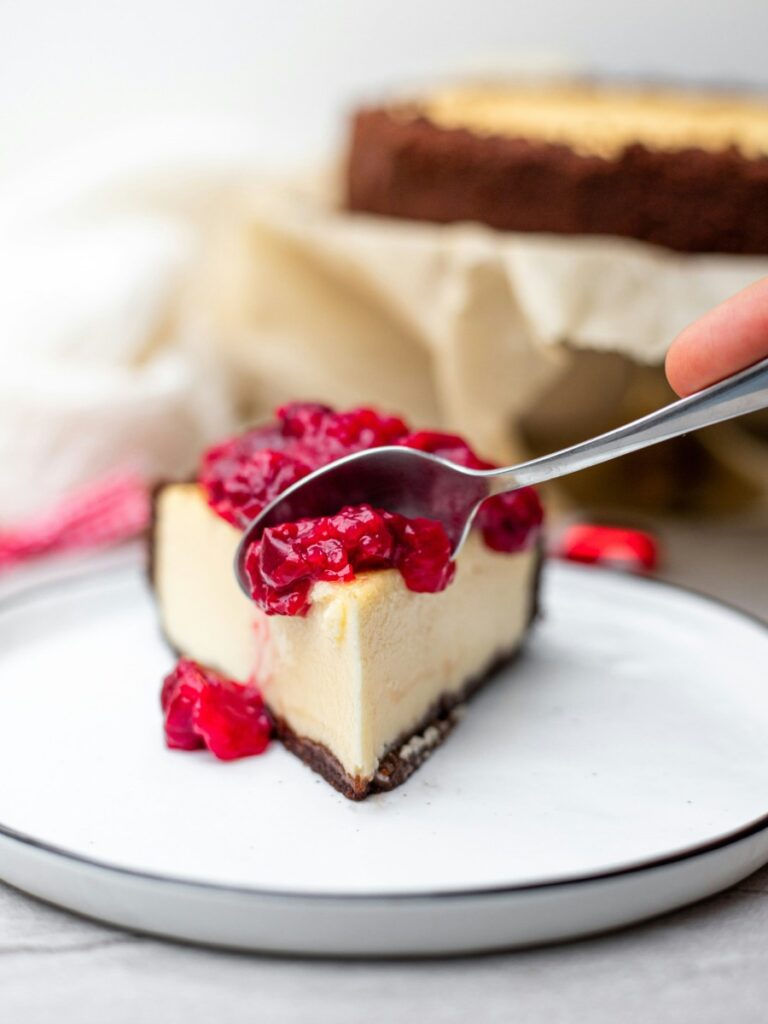
There are of course many iterations on the cheesecake theme. These vary between baked or non-baked, with or without crust, dense or light, chocolate or fruit themed, regular or vegan, and variously named “nationalities,” such as “Philadelphia,” “Chicago,” “Japanese,” “Roman,” “Swedish,” and “New York.”
Out of all of these I’d always been intrigued by, but never tried, New York Cheesecake. Why “New York” I wondered and what was the connection between the Big Apple and this cheesecake. As I was to find out, big is the defining feature of both.

According to an article called “Origin of a Classic: Cheesecake” published on the website Bakefromscratch, Arnold Reuben, a Jewish-German immigrant who founded the legendary Reuben’s Restaurant in New York in 1908, is credited with creating the New York Cheesecake in the 1920s. That others also vie for the title of creator goes without saying, as by the 1900s cheesecake had become the latest craze in New York and most restaurants had their own versions.
As with other dishes that have become classics, there’s a certain amount of didacticism in regard to the recipe, including such things as the inclusion or not of sour cream, the type of biscuit that should be used for the crust, the need for a hot water bath when baking, how long to refrigerate it before serving, and whether it should be served plain or with fruit and/or cream.
What is indisputable is that you need cream cheese – lots of it. That cream cheese itself also owes its creation to American inventiveness is not commonly known. According to the website cheesecake.com, in 1872 a New York dairy farmer, in attempting to replicate Neufchâtel cheese, stumbled upon the process for making cream cheese, soon to be packaged and sold under the brand name still widely available today, Philadelphia Cream Cheese. (Despite being created in New York the cheese was named after Philadelphia, a centre of excellence at the time for premium food, an acceptable practice in those times before the introduction of the Geographical Indication requirement).
With this compelling background, and because on my one visit there, I fell in love with New York, I had to try it.
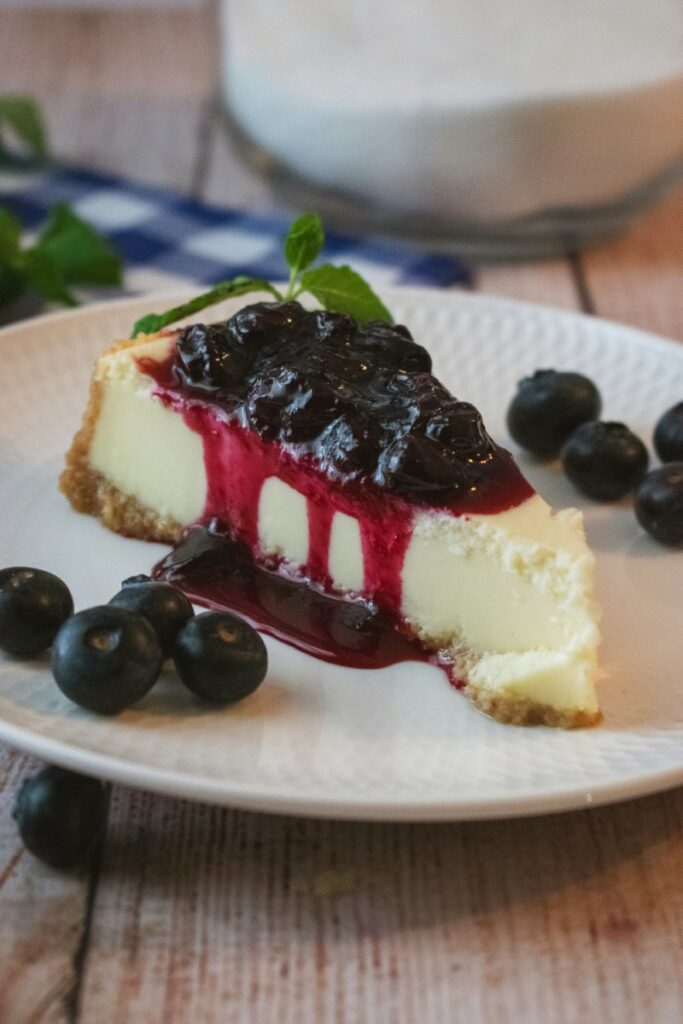
Compared to other cheesecakes, the New York is bigger, in height, density and mouthful. To achieve this distinction, the recipe calls for a greater proportion of cream cheese in relation to other ingredients, which gives you a thicker, creamier batter, a firmer texture and a tighter crumb when cooked. It also uses more eggs, four to five as compared to two to three for other kinds of cheesecake. It’s apparently the extra egg yolks that impart the signature New York flavour.
To make the biscuit crumb crust, the classic recipe calls for Graham crackers, which aren’t readily available in Australia. I’ve used several other varieties, including Scotch shortbread and Dutch Speculaas spiced cookies, all of which work well. I’ve also experimented with including crushed walnuts and a pinch of cinnamon, both of which enhance the flavour. There seems no clear consensus on whether a single or double crumb crust is preferred (single meaning base only and double extending up the sides as well). Given the height and richness of this cheesecake though, I think a double crust makes it too heavy.
I’m not sure why sour cream is a contentious issue, but on the basis that it adds to the creaminess, gives added moisture and imparts a tangy flavour, it seems a good idea and my recipe includes it. You can even use sour cream as a topping, by blending it with a touch of sugar. Once the cheesecake is baked, you coat it with the sour cream topping and place it back in the oven for a few minutes to set. I haven’t tried this. For an even more pronounced tang you can also include lemon zest and juice.
Purists insist the dish should be served plain, apart from perhaps a light sprinkling of icing sugar. Many recipes however pair it with a berry topping, which is a more aesthetic presentation in my view, providing a striking contrast in colours, textures and flavours. I couldn’t resist the idea of this and made a mulberry topping (the freezer still bulging with the frozen summer bounty of our prolific little mulberry trees). And just to ensure it was as calorific as humanly possible, I served it with plenty of cream.
According to all commentators, the most deplorable blunder is cracking. Anything from a small fissure to a replica of the Grand Canyon is verboten. It’s for this reason that many advocate a hot water bath (or bain-marie) during baking. Anyone who’s bathed anything, besides themselves, will attest this is a lot of messing about. Again, I decided to break the rules and didn’t use one. I’m happy to report that the recipe below doesn’t call for one and mine turned out high, wide, smooth and crack-free (more a case of beginner’s luck than skill I suspect).
Something to keep in mind in case you’re looking for a quick, last-minute dessert is that after baking the cheesecake needs refrigeration for at least 12 hours before serving.
When it came to the ultimate test, my dinner party cheesecake was a resounding success. It looked good — buttery, nutty crust enfolding a lofty slice of rich, dense creamy cheesecake, over which drizzled the deep purple mulberry topping in all its succulent juiciness. An artistic masterpiece, its beauty only superseded by its taste. Truly the big cheese of cheesecakes. Hedonistic, indulgent and decadent, but so worth it.
All that said however, last Christmas I discovered the Basque Cheesecake (often called Burnt Basque Cheesecake) which definitely gives the NY version a run for its money.
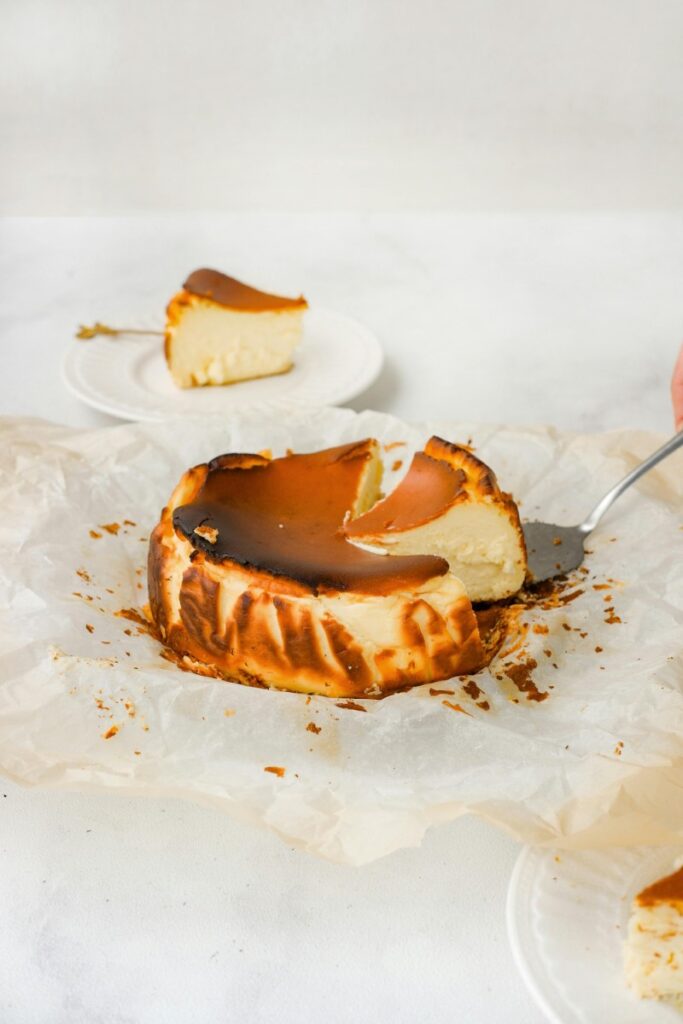
“Discovered” in this context doesn’t mean it’s a new dish, it simply means I’m late to the party. In fact, it’s far from new, having been around for centuries. It gets its name from its place of origin, the Basque region of Spain, where it’s said to have been created by local shepherds. Its Spanish name is “tarta de queso” or “gazda tarto.” Attention was first drawn to it, so the story goes, by its appearance on the menu at La Viña, a small pintxo bar in San Sebastián, after which Marti Buckley included it in her cookbook “Basque Country” published in 2018. La Viña, a family run enterprise, dates back to 1959 and is located in the old quarter of San Sebastián.
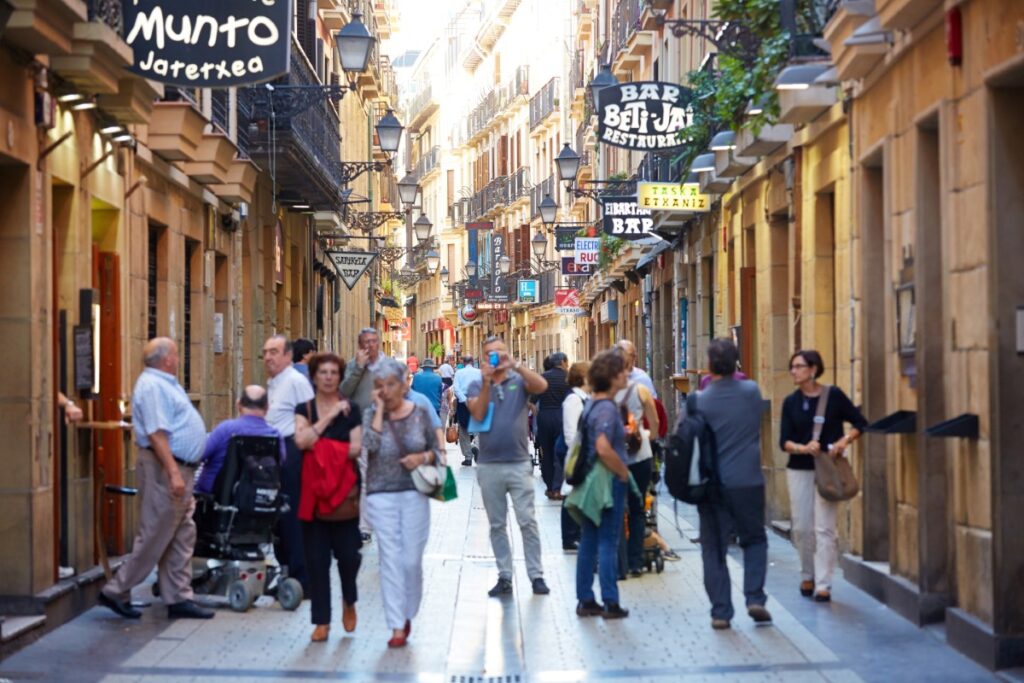
According to an article on the National Geographic website called “The Story Behind Burnt Basque Cheesecake”, thanks to social media, it’s become a very big thing. So much so that in 2021 the New York Times declared it “flavor of the year.”
Basque cheesecake is characterised by a burnt, almost charred looking exterior (as if it’s been left too long in the oven) and no crumb crust. Compared to New York, Basque has a lighter, more soufflé like texture and it’s baked at a high temperature, which accounts for the bronzed top and the crinkly brown crusted sides. Overall, it’s a quite rustic looking creation, often served simply on the paper it’s cooked in. Composed of only cream cheese, sugar, eggs and flour, the batter is thick and dense and when cooked has a creamy, custard-like texture. The rather alarming burnt appearance is created by the caramelisation of the ingredients, resulting in a combination of tangy, creamy, caramel and browned butter flavours. As it cooks it rises like a soufflé which then sinks a bit in the centre after it’s removed from the oven. Like its New York cousin, it’s traditionally served plain, although, because of the natural depression in the surface, it’s ideal for topping with fruit, cream and the like.
In terms of comparing the two, unfortunately there’s no healthy or even mildly heathy option. While the Basque is marginally less calorific, they’re both rich in sugar and fat, but on the plus side, very high on the naughty indulgence scale. Basque Cheesecake has a more subtle flavour, being slightly less sweet than New York and its texture is silkier. Otherwise, the choice depends on personal taste. Presentation-wise the New York version is perhaps more impressive, because of the classic structure of crumb crust foundation supporting an edifice of creamy delight, however in terms of taste and ease of preparation, the Basque version might just be a nose ahead.
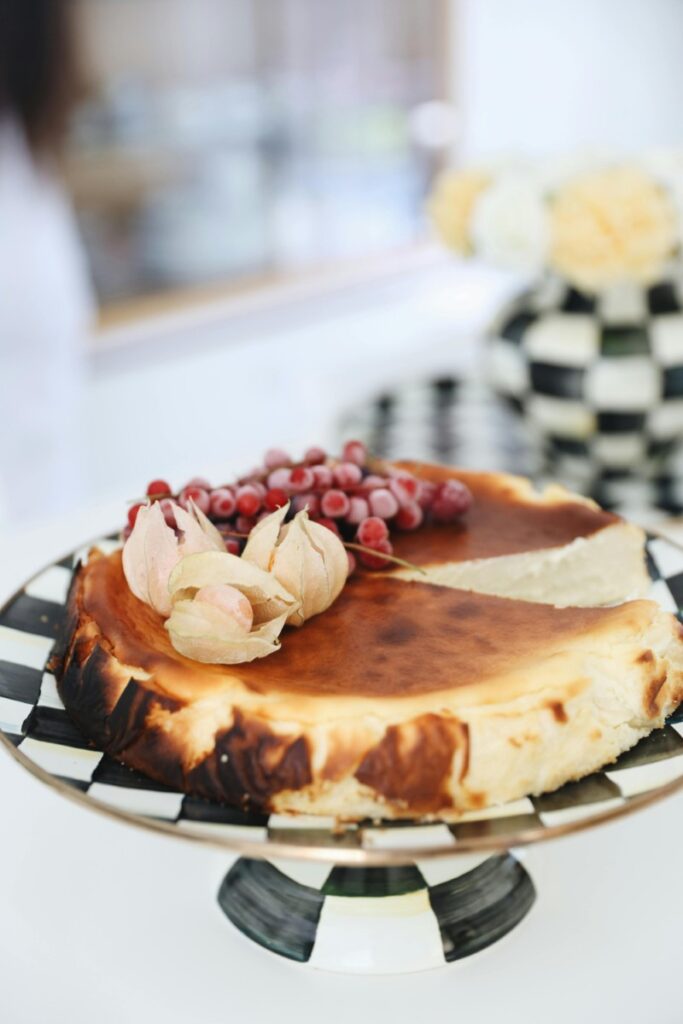
My “discovery” of the Basque, albeit tardy, seemed serendipitous at the time as I was looking for a special dessert to take to a Christmas lunch party, at which, coincidentally, some of the same guests from the New York Cheesecake event were to be present. A Christmas edition of a food retailer’s magazine contained a recipe for “Basque Cheesecake with Caramelised Banana and Hazelnut Praline”, accompanied by a photo of a magnificently extravagant looking creation. Going way beyond the concept of Basque Cheesecake as the kind of simple, rustic dish you might find in an unpretentious Spanish bar, this version flung itself into sybaritic realms that would have horrified the chef at La Viña, not only gilding the lily with banana, caramel and hazelnut praline, but lashings of brandy flavoured cream as well.
At the time, this recipe struck me as visionary, so I plunged in. As an introduction to Basque Cheesecake, it was a resounding success and made me an instant convert. Caramelised banana however on top of all that cream, sugar and so on, seemed an embarrassment of carbs, so I used caramelised apricots instead, but I did keep the cream and the hazelnut praline. Profligacy of course is excusable at certain times of the year, but is better reined in at others, so my next Basque Cheesecake was a model of restraint, which didn’t in fact detract at all from its beauty. Like many things in life, to tamper with the essence of something so good is to do it a disservice.


